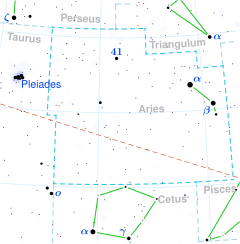Eta Arietis
| Observation data Epoch J2000 Equinox J2000 | |
|---|---|
| Constellation | Aries |
| Right ascension | 02h 12m 48.08568s[1] |
| Declination | +21° 12′ 39.5776″[1] |
| Apparent magnitude (V) | 5.231[2] |
| Characteristics | |
| Spectral type | F5 V[3] |
| U−B color index | –0.04[4] |
| B−V color index | +0.44[4] |
| Astrometry | |
| Radial velocity (Rv) | +4.5[2] km/s |
| Proper motion (μ) | RA: +163.917[1] mas/yr Dec.: +5.000[1] mas/yr |
| Parallax (π) | 33.3383 ± 0.1196 mas[1] |
| Distance | 97.8 ± 0.4 ly (30.0 ± 0.1 pc) |
| Absolute magnitude (MV) | +2.93[2] |
| Details | |
| Mass | 1.21[5] M☉ |
| Radius | 1.823[6] R☉ |
| Luminosity | 6.0[6] L☉ |
| Surface gravity (log g) | 4.01[3] cgs |
| Temperature | 6,700[6] K |
| Metallicity [Fe/H] | –0.35[3] dex |
| Rotational velocity (v sin i) | 9[7] km/s |
| Age | 2.6 Gyr[2] 3.98[5] Gyr |
| Other designations | |
| Database references | |
| SIMBAD | data |
Eta Arietis, Latinized from η Arietis, is the Bayer designation for a star in the northern constellation of Aries. It is dimly visible to the naked eye with an apparent visual magnitude of 5.231.[2] With an annual parallax shift of 33.34 mas,[1] the distance to this star is approximately 97.8 light-years (30.0 parsecs). It is drifting further away with a radial velocity of +4.5 km/s.[2]
This is an F-type main sequence star with a stellar classification of F5 V.[3] It is younger than the Sun at an age of about 2.6 billion years.[2] The effective temperature of the outer atmosphere is 6,380 K,[3] giving it the yellow-white-hued glow of an F-type star. Eta Arietis was examined using the HARPS instrument for radial velocity variations that may be caused by an orbiting companion, but no signal was detected.[8] Nor has an infrared excess been detected using the Spitzer Space Telescope, which might otherwise indicate the presence of circumstellar gas or dust.[9]
References
[edit]- ^ a b c d e f Brown, A. G. A.; et al. (Gaia collaboration) (August 2018). "Gaia Data Release 2: Summary of the contents and survey properties". Astronomy & Astrophysics. 616. A1. arXiv:1804.09365. Bibcode:2018A&A...616A...1G. doi:10.1051/0004-6361/201833051. Gaia DR2 record for this source at VizieR.
- ^ a b c d e f g Holmberg, J.; Nordström, B.; Andersen, J. (July 2009), "The Geneva-Copenhagen survey of the solar neighbourhood. III. Improved distances, ages, and kinematics", Astronomy and Astrophysics, 501 (3): 941–947, arXiv:0811.3982, Bibcode:2009A&A...501..941H, doi:10.1051/0004-6361/200811191, S2CID 118577511.
- ^ a b c d e Cenarro, A. J.; et al. (January 2007), "Medium-resolution Isaac Newton Telescope library of empirical spectra - II. The stellar atmospheric parameters", Monthly Notices of the Royal Astronomical Society, 374 (2): 664–690, arXiv:astro-ph/0611618, Bibcode:2007MNRAS.374..664C, doi:10.1111/j.1365-2966.2006.11196.x, S2CID 119428437.
- ^ a b c "eta Ari". SIMBAD. Centre de données astronomiques de Strasbourg. Retrieved 2012-08-04.
- ^ a b Luck, R. Earle (January 2017), "Abundances in the Local Region II: F, G, and K Dwarfs and Subgiants", The Astronomical Journal, 153 (1): 19, arXiv:1611.02897, Bibcode:2017AJ....153...21L, doi:10.3847/1538-3881/153/1/21, S2CID 119511744, 21.
- ^ a b c Schofield, Mathew; Chaplin, William J.; Huber, Daniel; Campante, Tiago L.; Davies, Guy R.; Miglio, Andrea; Ball, Warrick H.; Appourchaux, Thierry; Basu, Sarbani; Bedding, Timothy R.; Christensen-Dalsgaard, Jørgen; Creevey, Orlagh; García, Rafael A.; Handberg, Rasmus; Kawaler, Steven D. (2019-03-01), "The Asteroseismic Target List for Solar-like Oscillators Observed in 2 minute Cadence with the Transiting Exoplanet Survey Satellite", The Astrophysical Journal Supplement Series, 241 (1): 12, arXiv:1901.10148, Bibcode:2019ApJS..241...12S, doi:10.3847/1538-4365/ab04f5, ISSN 0067-0049 eta Arietis' database entry at VizieR.
- ^ Takeda, Yoichi; et al. (February 2005), "High-Dispersion Spectra Collection of Nearby F--K Stars at Okayama Astrophysical Observatory: A Basis for Spectroscopic Abundance Standards", Publications of the Astronomical Society of Japan, 57 (1): 13–25, Bibcode:2005PASJ...57...13T, doi:10.1093/pasj/57.1.13.
- ^ Lagrange, A.-M.; et al. (February 2009), "Extrasolar planets and brown dwarfs around A-F type stars. VI. High precision RV survey of early type dwarfs with HARPS", Astronomy and Astrophysics, 495 (1): 335–352, arXiv:0809.4636, Bibcode:2009A&A...495..335L, doi:10.1051/0004-6361:200810105, S2CID 62894956.
- ^ Trilling, D. E.; et al. (February 2008), "Debris Disks around Sun-like Stars", The Astrophysical Journal, 674 (2): 1086–1105, arXiv:0710.5498, Bibcode:2008ApJ...674.1086T, doi:10.1086/525514, S2CID 54940779.

